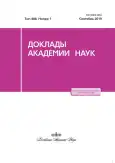Structural-induced lubricity of liquid crystal nanomaterials of cholesterol at metal friction
- Authors: Kolesnikov V.I.1, Ermakov S.F.2, Shershnev E.B.2, Sychev A.P.3
-
Affiliations:
- Rostov State Transport University
- Francisk Skorina Gomel State University
- Federal State Budget Institution of Science "Federal Research Center The Southern Scientific Centre of the Russian Academy of Sciences"
- Issue: Vol 488, No 1 (2019)
- Pages: 24-28
- Section: Theoretical physics
- URL: https://journals.eco-vector.com/0869-5652/article/view/16191
- DOI: https://doi.org/10.31857/S0869-5652488124-28
- ID: 16191
Cite item
Abstract
Experimentally, it was found that with the change in temperature there is a structural-induced increase in the lubricating capacity of liquid-crystal nanomaterials induced by transformations in the cholesteric mesophase. It is shown that in this temperature range, the minimum values of the friction coefficient practically coincide with the peak values of the dynamic viscosity, which together indicates in favor of the ordered state of the cholesterol liquid-crystal structures at these temperatures. As a result, it can be assumed that in this temperature range, spirally twisted layers of liquid-crystal cholesterol molecules with high antifriction action are formed in the friction zone. It is noted that the thickness of the friction-implemented cholesteric liquid-crystal films is sensitive to temperature changes in the contact area, changing the color and energy loss.
About the authors
V. I. Kolesnikov
Rostov State Transport University
Author for correspondence.
Email: rek@rgups.ru
Academician of the Russian Academy of Sciences
Russian Federation, 2, Rostovskogo Strelkovogo Polka Narodnogo Opolcheniya sq., Rostov-on-Don, 344038S. F. Ermakov
Francisk Skorina Gomel State University
Email: rek@rgups.ru
Belarus, 104, Sovetskaya str., Gomel, 246019
E. B. Shershnev
Francisk Skorina Gomel State University
Email: rek@rgups.ru
Belarus, 104, Sovetskaya str., Gomel, 246019
A. P. Sychev
Federal State Budget Institution of Science "Federal Research Center The Southern Scientific Centre of the Russian Academy of Sciences"
Email: rek@rgups.ru
Russian Federation, 41, Chekhova street, Rostov-on-Don, 344006
References
- Колесников В.И., Ермаков С.Ф., Сычев А.П. // ДАН. 2009. Т. 426. № 5. С. 617-620.
- Gnecco E., Meyer E. Fundamentals of Friction and Wear on the Nanoscale. Switzerland: Springer International Publishing, 2015. 704 p.
- Ермаков С.Ф. Трибология жидкокристаллических наноматериалов и систем. Минск: Беларусская навука, 2012. 380 с.
- Евдокимов Ю.М., Захаров М.А., Скуридин С.Г. // Вестник РАН. 2006. Т. 76. № 2. С. 112-120.
- Ermakov S.F., Myshkin N.K., Kolesnikov V.I., Sychev A.P. // J. Friction and Wear. 2015. V. 36. № 6. P. 496-501.
- Ermakov S.F. // J. Friction and Wear. 2003. V. 24. № 2. P. 4-50.
- Капустин А.П. Экспериментальные исследования жидких кристаллов. М.: Наука, 1978. 368 с.
- Сонин А.С. Введение в физику жидких кристаллов. М.: Наука, 1983. 320 с.
- Беляков В.А. Оптика холестерических жидких кристаллов. М.: Наука, 1982. 360 с.
- Ахматов А.С. Молекулярная физика граничного трения. М: Физматгиз, 1963. 472 с.
Supplementary files








